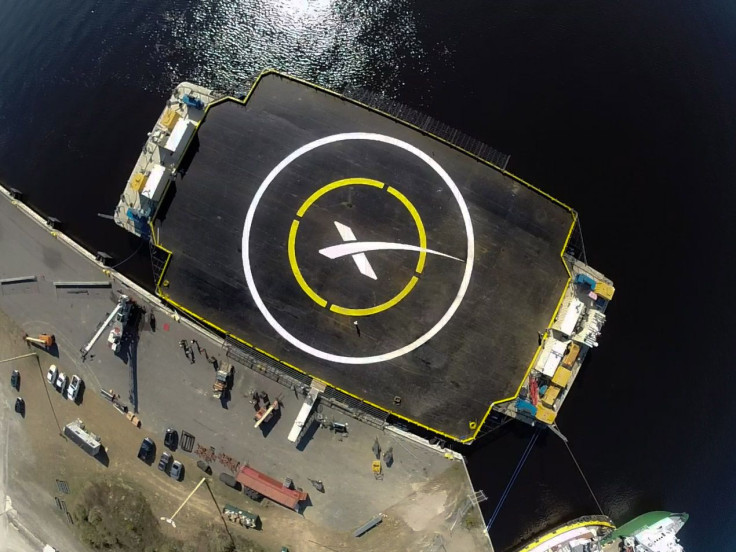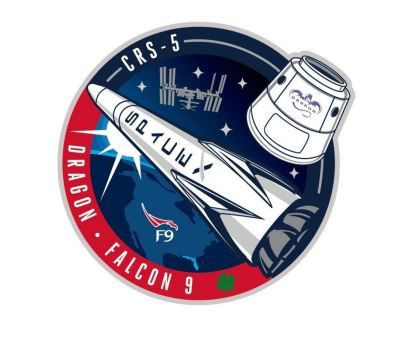SpaceX Launch Will End With An Attempt To Land A Falcon 9 Rocket On A Platform In The Atlantic Ocean

SpaceX will launch the fifth commercial resupply mission to the International Space Station on Tuesday. As part of its contract with NASA, SpaceX will deliver more than 2.5 tons of cargo and scientific investigations to the space station, but watchers will be particularly interested in the last part of the mission, after the Dragon spacecraft separates from the Falcon 9 rocket. In its latest attempt to create a reusable rocket, SpaceX will attempt to soft-land the first stage of the Falcon on a platform in the Atlantic Ocean.
The California company founded by Elon Musk attempted three soft landings in the Atlantic Ocean in 2014, including one in April, but SpaceX was unable to recover the rocket. The first attempt at landing on an ocean platform, measuring 300 by 100 feet, will be no easy task. As the company noted in its blog, it will be like "trying to balance a rubber broomstick on your hand in the middle of a wind storm."
SpaceX estimates its odds of successfully pulling off such a feat at less than 50 percent, but the outcome is not too important since the attempt will provide valuable insight into the feasibility of such a landing and the Falcon 9's new hypersonic grid fins.
A Falcon 9 rocket consists of a first stage, containing nine Merlin rockets and the propellant tanks; the interstage connecting the first and second stages; the second stage, which delivers the payload to orbit; and the Dragon spacecraft. During the launch, the spacecraft's berthing mechanism will be covered by a protective shell. SpaceX wants to make the Falcon 9's first stage completely reusable and capable of a soft landing on Earth. A reusable rocket would greatly reduce the cost of launches, which is pivotal in a future mission to Mars or ferrying astronauts to the space station in 2017.
Any attempt to recover the first stage, measuring "14 stories tall and traveling upwards of 1,300 meters per second (nearly a mile per second)," will require several engine burns to adjust and slow the rocket. SpaceX will perform three burns Tuesday: The first points the rocket into position while the second reduces its speed. The third burn will further slow the rocket as the rocket's landing legs are deployed.
The ocean platform is a free-floating ship, but will have thrusters to keep it in place for the attempt. With such little margin for error -- SpaceX is hoping for a landing accuracy of 10 meters (32.8 feet) -- the Falcon 9 was upgraded with new fins to improve precision. The hypersonic grid fins, configured in a "X" pattern, can be independently controlled and adjusted during the attempt.

Tuesday's launch is scheduled for 6:20 a.m. EST from Launch Complex 40 at the Cape Canaveral Air Force Station in Florida and lasts just over 10 minutes. The nine Merlin engines ignite just before launch, and a little over a minute after liftoff the Falcon 9 rocket reaches supersonic speed. At 2 minutes, 37 seconds, the first-stage engines are shut off and the first and second stages separate eight seconds later. The second stage will burn for seven minutes, bringing the Dragon spacecraft into low-Earth orbit. Nine minutes, 27 seconds after launch, the second stage engine is shut off and the spacecraft separates 37 seconds after the shutoff. After separation, Dragon deploys its solar arrays, stowed during launch, and chases the space station for two days. The spacecraft will be grappled by NASA astronaut Barry Wilmore, Expedition 42 commander, and European Space Agency astronaut Samantha Cristoforetti Thursday at approximately 8 a.m. EST.
For SpaceX, even failure would be considered a success, and it looks forward to another 12 launches to a soft landing on an ocean platform, the New York Times reported. "I think it’s quite likely, 80 to 90 percent likely, that one of those flights will be able to land and refly," Musk told the Times.
© Copyright IBTimes 2024. All rights reserved.






















